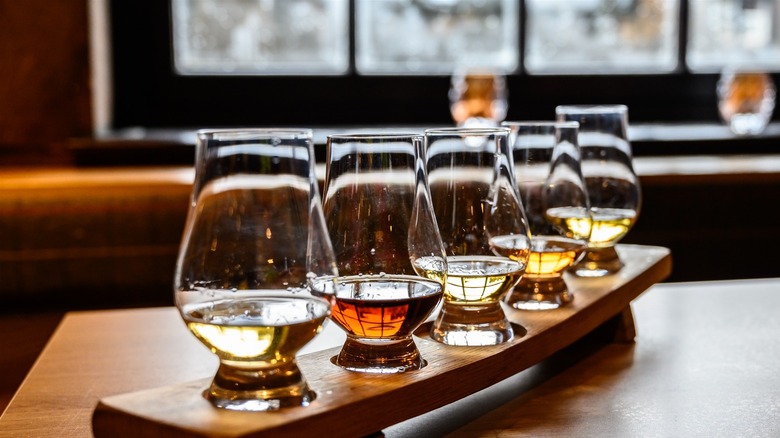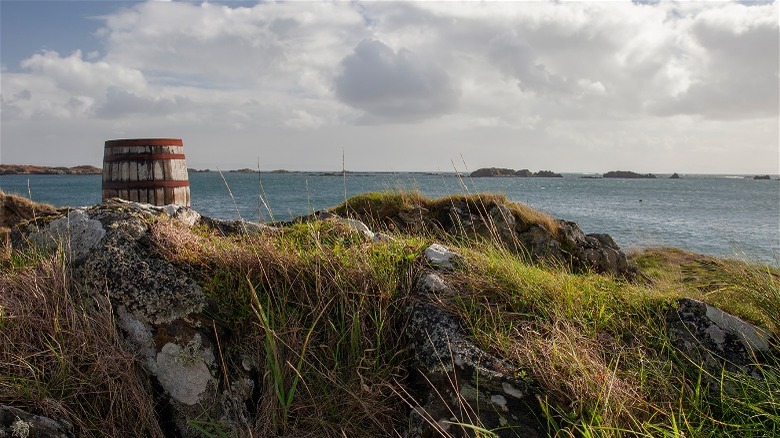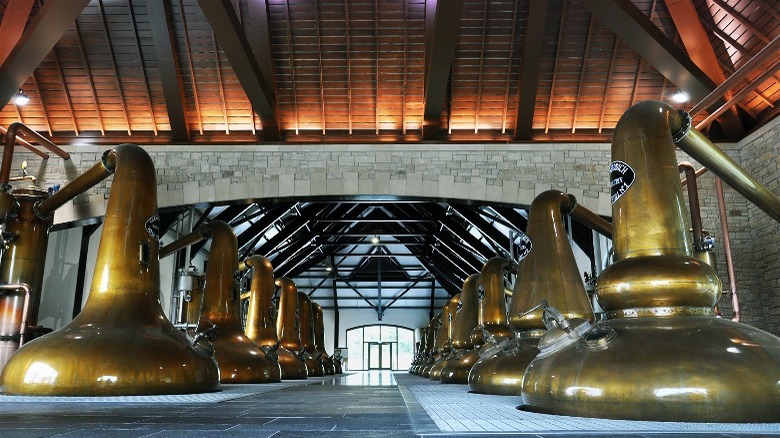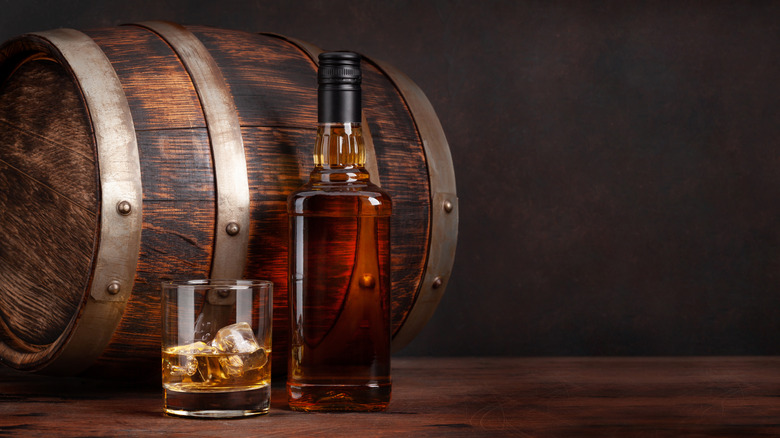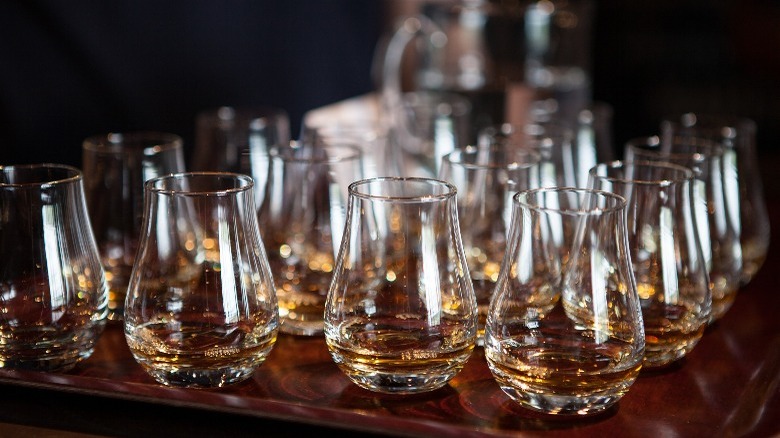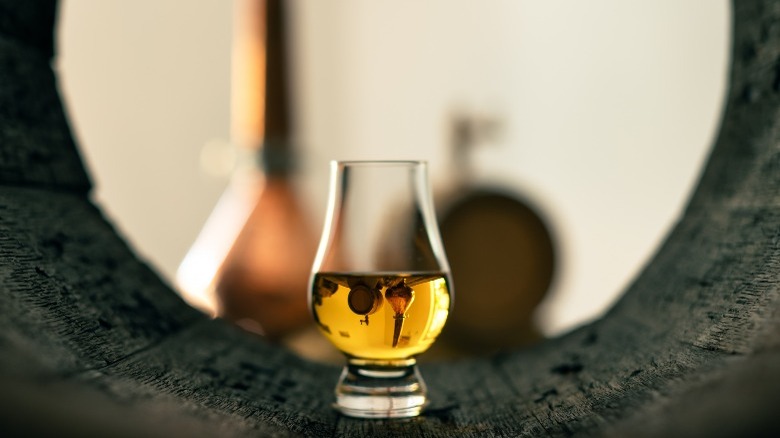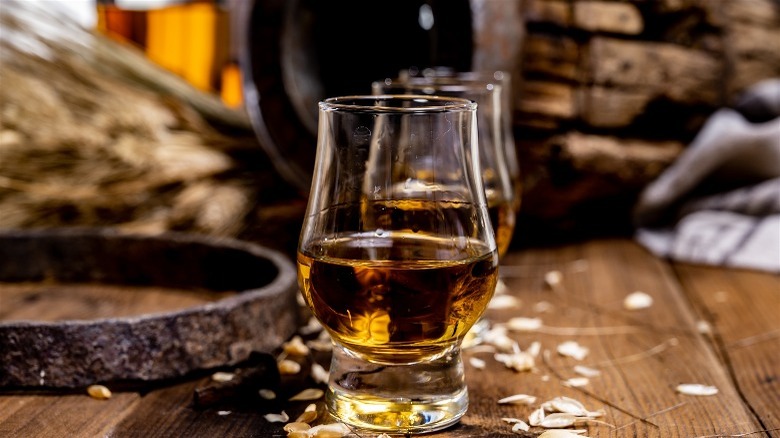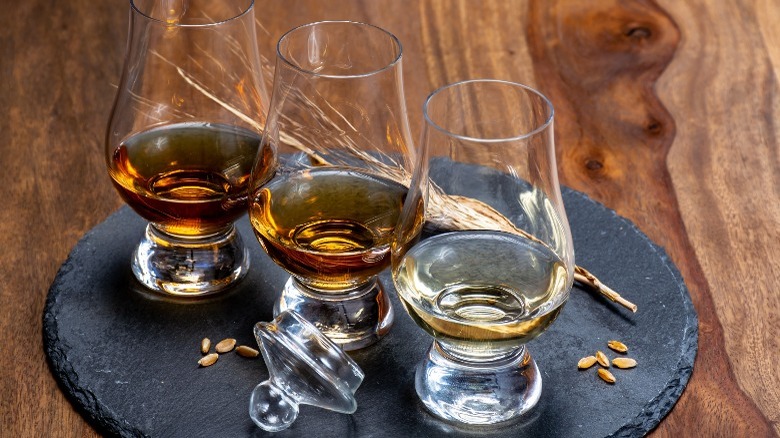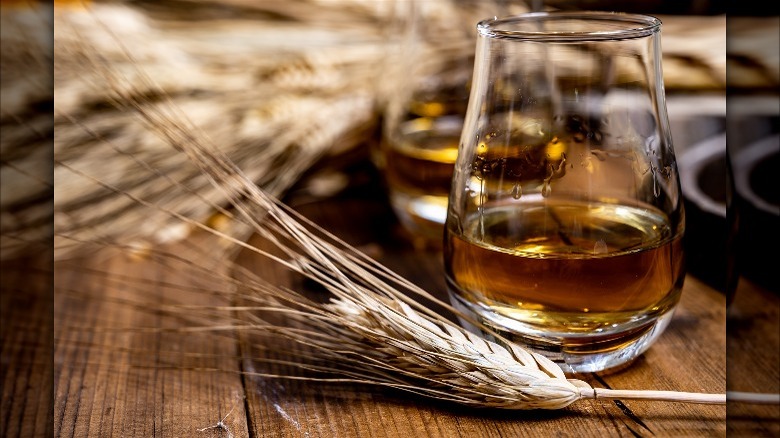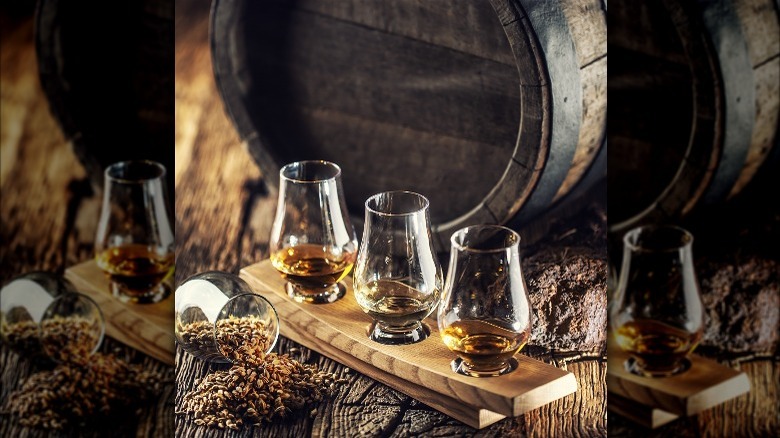5 Types Of Scotch That Will Transport You To Scotland
Just one sip — or even a mere whiff — of Scotch will tell you there's something different about this spirit. The aromas change based on how long it's been aged and other factors, but you can often expect to be taken on a journey. Smoke, citrus fruits, dark cherries, and vanilla are just some of the lively aromas in any given glass of Scotch.
If you've ever wanted to know what to look out for when picking up your next bottle of Scotch, we've prepared a rundown just for you. But first things first, it's important to note that Scotch is indeed a type of whisky. And yes, that is "whisky" not "whiskey"; the latter applies to whiskeys made in the United States and Ireland. Scotch is hugely popular in the United Kingdom, and it has made its way all around the world. Today, Johnnie Walker is the most sold brand and sells as much Scotch as its three closest competitors, according to ScotchWhisky.com. In total there are only five types of Scotch, but we've broken them down to give you a clear idea of how to distinguish one from the other.
While a glass of whisky cannot actually replicate the experience of traveling to Scotland, pouring yourself one of the five types of Scotch whiskies and watching the Open Championship at St Andrews is not a bad alternative. Keep reading to deep dive into the national drink of Scotland.
Origins of Scotch whisky
Let us settle in for a quick history lesson, shall we? Per The Scotch Whisky Experience, the word "whisky" can be traced back to "usquebaugh," which is Gaelic for "water of life"; as early as the 16th century, whisky was used medicinally. As for when it was invented? That remains unknown, but the first writing about whisky is believed to date all the way back to 1494.
Per the National Trust of Scotland, in 18th century Scotland, the government established a licensing system to manage the whisky boom. Illicit whisky production affected many parts of society, particularly in the Scottish Highlands. The Excise Act of 1823 was enacted, which decreased taxes and made whisky production, once again, more affordable.
In the 1870s, whisky was produced in Scotland and Ireland. When Irish exporters decided to bring their whisky to the United States, they added an "e" to make it clear which whisky was which, according to Master of Malt. So today, you may notice different spellings, which are both accurate depending on the brand in question. As much as there seems to be a distinction between Scotch whisky and Irish whiskey, the histories are undoubtedly intertwined. John Jameson was perhaps the reason Irish whisky is what it is today... but as Scotch Whisky.com notes, he was Scottish. So while the lines of origin are blurred, one thing's clear: Scotch is a drink that has a storied history and an unmatchable flavor profile.
How Scotch whisky is made
Per the Scotch Whisky Experience, it takes four steps to make Scotch whisky. In the malting process, barley, which is the original grain used in Scotch, is cleaned and soaked in water for three days. The grain is then put on a malting floor allowing the starch in the barley to turn into sugar. This subprocess, called germination, can take up to almost two weeks, depending on the overall quality of the barley and time of year. After the germination is complete, the barley is spread out to dry.
During the mashing step, the dried grain is milled and mixed with water, turning it into a mash. The starch in the barley will continue to turn into sugar and then transforms into a liquid which is called wort. After the liquids will be separated from the solids, which are given to cattle after some processing. To the remaining liquid or wort, yeast is added, which transforms the sugars into alcohol. This fermentation process takes around 48 hours.
The liquid, now called wash, is heated in pot stills. These stills were historically made of copper and often have a long neck that is attached to a cauldron-like object. The liquid evaporates and the steam rises and it cools back into liquid, a process called distillation. This process will be repeated and the liquid is collected. The Scotch will be matured in oak wood casks. This last step can take 15 years or more and results in the whisky developing additional flavor.
Scotch vs. other types of whisky
Although one may be inclined to assume Scotch is totally identical to other versions of whisky, there are a few key distinctions that set this spirit apart from its relatives. There can be complicated rules surrounding what makes a certain beverage a certain beverage (here's looking at you, Champagne!), but the defining characteristic of Scotch is actually pretty simple: it must be made in Scotland. Hence the name.
Of course, there are a few more notable stipulations that set Scotch apart, including the rule that Scotch must be made of malted barley, per Whisky Advocate. According to MasterClass, the malted grains used in Scotch are what give it its unique flavor. Beyond that, Whisky Advocate explains that using any additives besides caramel coloring and water is a big no-no, and the ABV of the final product's got to reach 40%. Scotch must also be matured in oak casks, or barrels that aren't bigger than 700 liters. So again, while whiskys/whiskeys are part of the same liquor category, there are a number of crucial differences between Scotch, bourbon, Canadian whisky and so on.
How taste Scotch
Scotch can be served in a number of ways, be it neat, over ice, or in a classic whisky cocktail. But if you want to really dig into the whole Scotch whisky experience and discover the full spectrum of flavors, there are proper ways to go about doing just that.
First, look at the Scotch. See the color which can vary from a light gold shimmer to a deep dark amber. In general, you could say the darker the color, the longer the whisky has been aged, explains the Michelin Guide. Next, you'll use your sense of smell to distinguish the multiple flavors like rich desserts or citrus notes. Finally comes the tasting. Take a small sip and let the Scotch cover your taste buds to experience the complete profile.
Lastly, add a splash of water to your Scotch. Whereas adding ice would only cool down your Scotch, the water opens up the whisky and brings out more and different flavors, which the alcohol would otherwise hide.
Single malt Scotch whisky
Up first is the single malt Scotch. This category of whisky is determined by two main factors. First, as the name suggests, the whisky needs to be made at only one distillery within Scotland, according to Master of Malt. Now, while the name might also lead one to assume that it must be made of a single blend, that is not the case. Rather, single malt is technically a blend of different whiskies from different casks with different ages, but all of them have to come from one distillery. Single cask whisky, on the other hand, is a whisky that comes from only one cask.
The other primary classification of single malt is that malted barley is the only grain allowed. That said, the barley can be sourced from multiple places. These two factors plus the character of each and every distillery give single malt Scotch its distinct flavor profile. While it will differ slightly based on the distillers' methods, single malt Scotch often has notes of smoke and/or fruit.
Single grain Scotch whisky
A close relative to the single malt Scotch is single grain Scotch. Despite its name, the word "single" just defines that the scotch has to come from one distillery only (which may sound familiar, as those are the same rules as the single malt). But the distinction here is that the grain used in making those types of whiskies does not necessarily need to be only barley, according to Liquor.com.
It can be barley and another grain, like wheat or corn. The grain does not necessarily need to be malted either. This gives makers of a single grain whisky more room to play around with different ingredients to create a very unique Scotch. The final product is usually a blend of different whiskies from different years. As Distiller breaks down, these whiskies are considered a bit lighter and leaner compared to single malts and are often sold at a lower price point. This makes it a great Scotch to mix into cocktails. Whisky sour lovers and whisky soda lovers unite — you'll want to try this Scotch.
Blended grain Scotch whisky
Blended grain Scotch whisky is made just like the single grain — well, sort of. As the Scotch Advocate explains, to create a blended grain whisky, single grain whiskies are pulled from multiple distilleries and combined. You will not find malt Scotch whisky in blended grain Scotch whisky.
The flavor profile is in general much lighter compared to single malt or single grain scotch. As Ian MacLeod Distillers puts it, "Malt whisky = big punchy flavours, Grain whisky = light, delicate flavours." It has a very smooth finish, even though it usually has a higher ABV than, say, a single malt scotch. Like all other Scotch whisky, blended grain Scotch whisky must be aged for at least three years. That said, it is not uncommon to find types of Scotch that are aged for a much longer time.
Find My Whisky suggests you look out for a smooth, velvety texture and a lighter taste. There may be notes of cocoa, smoke, vanilla, clove, citrus, and eucalyptus.
Blended malt Scotch whisky
Blended malt is the sister to single malt; it is what blended grain is to single grain. Per The Scotch Advocate, this production process matches that of a single malt Scotch; the whisky can come from multiple distilleries. A blended malt whisky is a mix of at least two single malt Scotches, originating from two or more distilleries. Blended malt Scotch, which has also been called vatted malt and pure malt in the past, has become increasingly popular in recent years — and for good reason. As Sandy Hyslop of Chivas Regal told Whisky Advocate, "The beauty of blended whisky is that each component brings its unique character to the blend, to ultimately reveal a whisky that is even greater than the sum of its parts."
Blended malts are where many of the more creative distillers try their hands to unleash their experimental side. According to The Whisky Exchange, some blended malts contain more than 16 types of single malts. The blend of two or more single malts can create a more complex profile and smoother finish and is definitely worth a try.
Blended Scotch whisky
Blended Scotch whiskies are the most common type of Scotch and most accessible all over the world. Almost every major Scotch brand that consumers flock to, like Chivas Regal and Johnnie Walker, are blended whiskies. Production rules around this category of Scotch are more relaxed. Per The New York Times, a blended Scotch can include any combination of single malt, single grain, blended malt, and blended grain whisky. In addition to that, the whisky can be mixed with other neutral grain spirits and flavors to create an appealing taste and look. And, of course, the whisky must be aged for at least three years.
Because of these more relaxed blending regulations, blended Scotch has a flavor that seems to appeal to the masses. As The Scotch Advocate explains, blended whisky is responsible for 90% of whisky sales. This also makes the price point much more accessible compared to the other categories. The mix with other spirits and flavors, which results in a gentler flavor, can be the starting point of discovering the world of Scotch whiskies.
